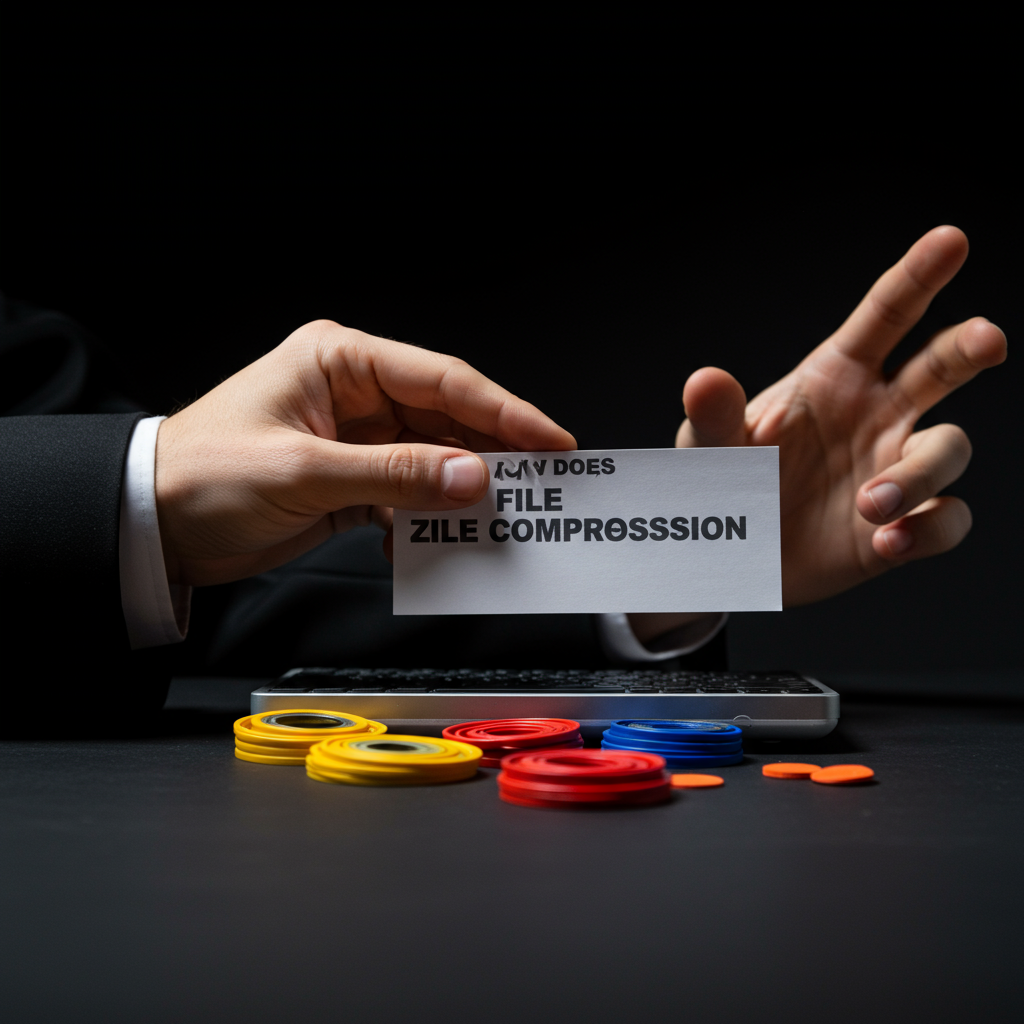Ever wondered how sending a bunch of photos, documents, or even a whole software program can be squeezed into a single, much smaller file, often ending with ‘.zip’? This digital magic trick is called file compression, and “zipping” is just one common way it’s done. It’s not actually magic, though; it’s a clever application of logic and pattern recognition designed to save space and speed up transfers. Think of it less like crushing a physical object and more like writing in shorthand.
At its heart, compression works by finding and reducing redundancy within a file’s data. Most files, whether they’re text documents, images, or program code, contain repetitive information. Your computer stores everything as sequences of bits – ones and zeros. Compression algorithms are smart procedures that scan these bits, identify patterns, and represent them more efficiently.
The Core Idea: Finding Patterns
Imagine a simple text file containing the line “AAAAABBBBBCCCCCCCC”. This sequence takes up 18 characters (or bytes, typically). A very basic compression technique could notice the repeating characters and represent it differently. Instead of writing ‘A’ five times, it could write something like “5A”, meaning “five A’s”. Doing this for the whole line gives us “5A5B8C”. This representation is much shorter – only 6 characters instead of 18! This simple example illustrates
Run-Length Encoding (RLE), one of the earliest compression methods. While modern algorithms are far more sophisticated, the fundamental principle remains: find repetition and describe it concisely.
Of course, most files aren’t just long strings of identical characters. They have more complex patterns. This is where more advanced techniques come into play.
Lossless vs. Lossy: Keeping or Losing Data?
Before diving deeper into how zipping works, it’s crucial to understand the two main categories of compression:
- Lossless Compression: This is the type used by standard file archiving tools like ZIP, RAR, 7z, and Gzip. The “lossless” part is key – it means that when you uncompress (or unzip) the file, you get back exactly the original data, bit for bit. Not a single piece of information is lost. This is essential for text documents, spreadsheets, program files, and databases where any change could corrupt the file or alter its meaning.
- Lossy Compression: This method achieves much higher compression ratios (smaller files) but does so by permanently discarding some data. It tries to remove information that humans are less likely to notice. This is commonly used for multimedia files like JPEG images, MP3/AAC audio, and MPEG/H.264 video. A slightly lower quality image or audio file is often an acceptable trade-off for a significantly smaller file size. You can’t get the discarded data back once it’s gone.
Zipping (using formats like ZIP or 7z) almost always employs lossless compression. When you zip a Word document, you expect to get the exact same document back when you unzip it, not one with missing words or altered formatting.
How Lossless Compression (Like Zipping) Works
Since zipping focuses on lossless methods, let’s explore the clever algorithms that make it happen without losing data. Most modern lossless compression, especially the DEFLATE algorithm used in standard ZIP files, combines two main techniques:
1. Dictionary-Based Compression (LZ77/LZ78 Variants)
This is a more advanced form of finding repetition than simple RLE. Imagine you’re reading a long book. You’ll notice that certain words and phrases appear many times (“the”, “and”, “once upon a time”). Instead of writing out the full phrase every single time after its first appearance, what if you could just refer back to where it first occurred?
Dictionary-based algorithms, like LZ77 (Lempel-Ziv 1977), do something similar with digital data. As the algorithm processes the file, it keeps track of the data it has recently seen (this acts as a “dictionary” or “sliding window”). When it encounters a sequence of bytes that it has already seen within that window, instead of writing out the sequence again, it writes a shorter pointer. This pointer essentially says, “Go back X bytes and copy Y bytes from there.”
For example, consider the text: “The quick brown fox jumps over the lazy dog. The quick brown fox was tired.”
When the algorithm reaches the second occurrence of “The quick brown fox”, it recognizes this sequence appeared earlier. Instead of writing out those 19 characters again, it might insert a special code like `(Pointer: distance=35, length=19)`. This pointer is usually much shorter than the 19 bytes it replaces. The longer and more frequent the repeated sequences, the more effective this technique becomes.
Different compression formats (ZIP, Gzip, 7z, RAR) often use variations and improvements on these Lempel-Ziv algorithms (like LZMA used in 7z), which allow for larger dictionaries or more efficient ways of finding matches, leading to better compression.
Verified Information: Lossless compression algorithms, such as those used in ZIP files (DEFLATE), primarily rely on identifying repeated sequences of data. They replace subsequent occurrences of these sequences with shorter references or pointers back to the original instance. This process preserves all original information, ensuring perfect reconstruction upon decompression.
2. Entropy Coding (Huffman Coding or Arithmetic Coding)
After the dictionary stage has replaced chunks of repeating data with pointers, there’s still room for optimization. The remaining data (literal characters and the pointers themselves) might still have statistical redundancy. Think about the English language: the letter ‘e’ appears far more often than ‘z’ or ‘q’.
Standard computer text encoding (like ASCII or UTF-8) usually assigns a fixed number of bits (e.g., 8 bits) to each character, regardless of how frequently it’s used. Entropy coding methods change this. They analyze the frequency of the remaining symbols (individual bytes or the pointers created by the LZ stage) in the data stream.
Huffman Coding is a classic example. It assigns variable-length codes to symbols: the most frequent symbols get the shortest codes, and the least frequent symbols get the longest codes. It cleverly constructs these codes so that no code is a prefix of another, ensuring the decoder can uniquely identify where each symbol ends. It’s like Morse code, where common letters like ‘E’ (.) and ‘T’ (-) have shorter representations than less common ones like ‘Q’ (–.-).
By representing common data elements with fewer bits, Huffman coding (or more advanced methods like Arithmetic Coding, which can often achieve slightly better compression) squeezes out more redundancy, further reducing the file size.
The DEFLATE algorithm, standard in ZIP files, uses a combination of LZ77 and Huffman coding. First, LZ77 finds and replaces repeated sequences with length-distance pairs. Then, Huffman coding is applied to compress the remaining literal bytes and the length-distance pairs themselves, making the final representation even more compact.
Why Doesn’t Zipping Make All Files Smaller?
You might notice that sometimes zipping a file doesn’t shrink it much, or might even make it slightly larger (though this is rare with modern archivers). Why?
- Already Compressed Data: Files that are already compressed using lossy methods (like JPEGs, MP3s, MP4s) or even other lossless methods have very little redundancy left for algorithms like DEFLATE to find. Trying to compress them again often yields minimal or no size reduction because the patterns have already been efficiently encoded. It’s like trying to write shorthand for something already written in shorthand.
- Truly Random Data: If a file consists of data that is essentially random (like encrypted data), there are no discernible patterns or repetitions for lossless compression algorithms to exploit. Compression attempts might fail to reduce size or even add a small overhead for the compression structures.
- Very Small Files: For extremely small files, the overhead of the zip archive format itself (file headers, dictionary information) might be larger than any savings gained from compressing the tiny amount of data.
- Inefficient Algorithms (Less Common Today): Older or simpler compression algorithms might not be as effective at finding complex patterns as modern ones.
Important Information: Do not expect significant size reduction when zipping files that are already compressed, such as JPEG images, MP3 audio, or video files (MP4, AVI). Attempting to re-compress these often yields negligible benefits. Furthermore, encrypting data typically makes it appear random, rendering subsequent lossless compression largely ineffective.
Putting It All Together
So, when you select files and choose “Send to > Compressed (zipped) folder” or use a tool like WinZip, 7-Zip, or WinRAR, here’s a simplified view of what happens:
- The compression software reads the data from the files you selected.
- It employs a lossless algorithm (like DEFLATE for standard ZIP).
- The algorithm scans the data, building a dictionary (or using a sliding window) to find repeated sequences (LZ77 stage).
- It replaces these sequences with shorter length-distance pointers.
- The remaining literal data and the pointers are then further compressed using an entropy coding method (like Huffman coding) that assigns shorter bit sequences to more frequent elements.
- The resulting compressed data, along with information needed for decompression (like the Huffman tables), is stored in the archive file (e.g., the .zip file).
When you unzip the file, the process reverses: the software reads the archive, uses the stored information to decode the entropy coding, reconstructs the pointers and literal data, and follows the pointers to rebuild the original repeated sequences, perfectly restoring your original files.
File compression is a testament to computational ingenuity, finding clever ways to represent information more efficiently by exploiting the inherent redundancy found in most data. It saves storage space, reduces bandwidth usage, and makes transferring files significantly faster – all by smartly rewriting data instead of just crushing it.
“`








